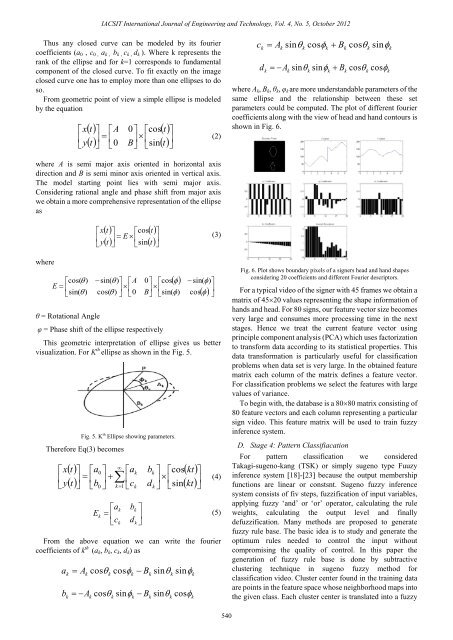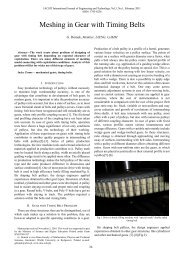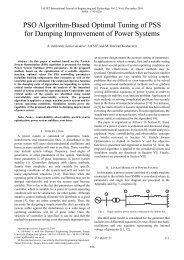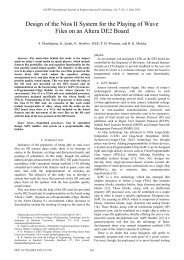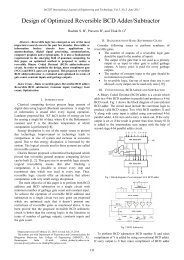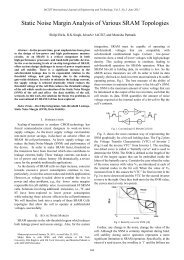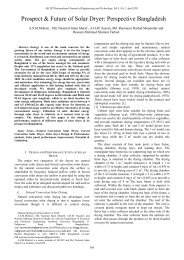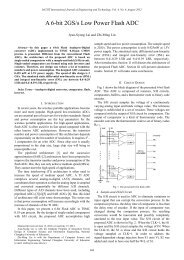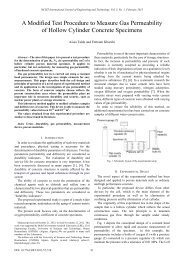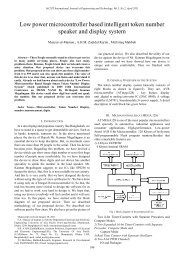A Video Based Indian Sign Language Recognition System ... - IJET
A Video Based Indian Sign Language Recognition System ... - IJET
A Video Based Indian Sign Language Recognition System ... - IJET
Create successful ePaper yourself
Turn your PDF publications into a flip-book with our unique Google optimized e-Paper software.
IACSIT International Journal of Engineering and Technology, Vol. 4, No. 5, October 2012<br />
Thus any closed curve can be modeled by its fourier<br />
coefficients (a 0 , c 0 , a k , b k , c k , d k ). Where k represents the<br />
rank of the ellipse and for k=1 corresponds to fundamental<br />
component of the closed curve. To fit exactly on the image<br />
closed curve one has to employ more than one ellipses to do<br />
so.<br />
From geometric point of view a simple ellipse is modeled<br />
by the equation<br />
x<br />
<br />
y<br />
t<br />
<br />
t<br />
<br />
A<br />
<br />
0<br />
0<br />
<br />
cos<br />
B<br />
<br />
sin<br />
t<br />
<br />
<br />
t <br />
(2)<br />
c<br />
k<br />
d<br />
A sin<br />
cos<br />
B cos<br />
sin<br />
k<br />
k<br />
k<br />
k<br />
A<br />
sin<br />
sin<br />
B cos<br />
cos<br />
k<br />
k<br />
where A k , B k , θ k , φ k are more understandable parameters of the<br />
same ellipse and the relationship between these set<br />
parameters could be computed. The plot of different fourier<br />
coefficients along with the view of head and hand contours is<br />
shown in Fig. 6.<br />
k<br />
k<br />
k<br />
k<br />
k<br />
k<br />
k<br />
where A is semi major axis oriented in horizontal axis<br />
direction and B is semi minor axis oriented in vertical axis.<br />
The model starting point lies with semi major axis.<br />
Considering rational angle and phase shift from major axis<br />
we obtain a more comprehensive representation of the ellipse<br />
as<br />
x<br />
<br />
y<br />
t<br />
<br />
t<br />
<br />
cos<br />
E <br />
sin<br />
t<br />
<br />
<br />
t <br />
(3)<br />
where<br />
cos(<br />
)<br />
E <br />
sin(<br />
)<br />
θ = Rotational Angle<br />
sin(<br />
)<br />
<br />
<br />
A<br />
cos( )<br />
<br />
0<br />
<br />
<br />
0<br />
<br />
cos<br />
B<br />
<br />
sin(<br />
)<br />
φ = Phase shift of the ellipse respectively<br />
sin(<br />
)<br />
<br />
cos<br />
<br />
<br />
This geometric interpretation of ellipse gives us better<br />
visualization. For K th ellipse as shown in the Fig. 5.<br />
Fig. 5. K th Ellipse showing parameters.<br />
Therefore Eq(3) becomes<br />
x<br />
<br />
y<br />
t<br />
<br />
t<br />
<br />
a<br />
<br />
b<br />
0<br />
0<br />
<br />
<br />
<br />
<br />
k1<br />
a<br />
<br />
c<br />
k<br />
k<br />
<br />
<br />
<br />
bk<br />
<br />
<br />
cos kt<br />
d<br />
<br />
k sin<br />
kt <br />
(4)<br />
ak<br />
bk<br />
<br />
E <br />
(5)<br />
k<br />
ck<br />
dk<br />
<br />
From the above equation we can write the fourier<br />
coefficients of k th (a k , b k , c k , d k ) as<br />
a<br />
b<br />
k<br />
k<br />
A cos<br />
cos<br />
B sin<br />
sin<br />
k<br />
k<br />
k<br />
k<br />
k<br />
A<br />
cos<br />
sin<br />
B sin<br />
cos<br />
k<br />
k<br />
k<br />
k<br />
k<br />
k<br />
k<br />
Fig. 6. Plot shows boundary pixels of a signers head and hand shapes<br />
considering 20 coefficients and different Fourier descriptors.<br />
For a typical video of the signer with 45 frames we obtain a<br />
matrix of 4520 values representing the shape information of<br />
hands and head. For 80 signs, our feature vector size becomes<br />
very large and consumes more processing time in the next<br />
stages. Hence we treat the current feature vector using<br />
principle component analysis (PCA) which uses factorization<br />
to transform data according to its statistical properties. This<br />
data transformation is particularly useful for classification<br />
problems when data set is very large. In the obtained feature<br />
matrix each column of the matrix defines a feature vector.<br />
For classification problems we select the features with large<br />
values of variance.<br />
To begin with, the database is a 8080 matrix consisting of<br />
80 feature vectors and each column representing a particular<br />
sign video. This feature matrix will be used to train fuzzy<br />
inference system.<br />
D. Stage 4: Pattern Classifiacation<br />
For pattern classification we considered<br />
Takagi-sugeno-kang (TSK) or simply sugeno type Fuuzy<br />
inference system [18]-[23] because the output membership<br />
functions are linear or constsnt. Sugeno fuzzy inference<br />
system consists of fiv steps, fuzzification of input variables,<br />
applying fuzzy „and‟ or „or‟ operator, calculating the rule<br />
weights, calculating the output level and finally<br />
defuzzification. Many methods are proposed to generate<br />
fuzzy rule base. The basic idea is to study and generate the<br />
optimum rules needed to control the input without<br />
compromising the quality of control. In this paper the<br />
generation of fuzzy rule base is done by subtractive<br />
clustering technique in sugeno fuzzy method for<br />
classification video. Cluster center found in the training data<br />
are points in the feature space whose neighborhood maps into<br />
the given class. Each cluster center is translated into a fuzzy<br />
540


